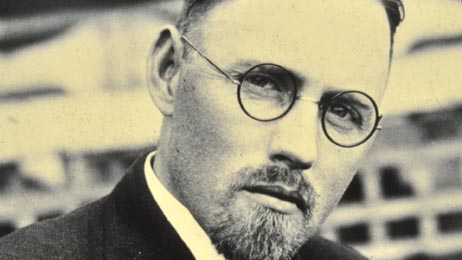Dr. John R. Brinkley: American Dream or Nightmare?

How a Jackson County, N.C., native went from richest doctor in the world to an infamous disgrace
Editor’s Note: This is the first of a two-week series written by Courier contributor Dr. Tom Cloer, Jr., about Dr. John R. Brinkley, Jr., born in neighboring Jackson County, N.C., and one of the most famous and successful men in the world in the 1930s before his unconventional methods and deceit led to his own fall from grace.
By Dr. Tom Cloer, Jr.
For the Courier
My maternal ancestors were here in the Pickens District in the 1700’s. But prior to the Civil War, my Great, Great Grandfather, Daniel Van Buren Moody, moved to East LaPorte, North Carolina, in Jackson County. Jackson County at that time bordered the Pickens District. My Great Grandfather, John Thomas Moody, son of Daniel Van Buren Moody, married Emma Wike there, and together they amassed an enormous amount of rich bottom land in the fertile Tuckasegee Valley. Therefore, throughout my life I have traveled in Jackson County to visit relatives.
Introduction
“Look Dad! What’s that written with orange rocks in that big rock wall?” I asked as a curious 6-year-old. The name can still be seen in the huge stone wall to this day spelled out in orange-colored river rocks. This is on North Carolina Highway 107 above Sylva, N.C., and Western Carolina University going toward Cashiers Valley.
“That’s the name ‘Brinkley,’” Dad answered. “He was born right here in Jackson County, and became the richest doctor in the world in the 1930s.”
“How did he get so rich?” I asked as I lifted the lid on Pandora’s box.
“Uh!” Dad said to a 6-year-old with huge ears, while looking at Mom and hesitating, “He performed operations.”
“What kind of operations?” I said, gaining interest as I leaned forward toward Dad driving the old 1940s Ford. I could tell by my parents’ demeanor that I had entered an interesting, unplowed area.
Dad dug deeply for his reply. “Tom, he just operated on men who felt old, and wanted to feel young.” He glanced quickly at Mom as if he needed assurance his answer was OK.
“Look!” Dad said as we continued driving north on Highway 107 in the Tuckasegee Gorge from Sylva toward Cashiers. “Those two monuments there at the pull-out; those are about John Brinkley.”
“Pull over Dad, and let’s see what they say.”
“I know what they say, Tom. One put up by North Carolina calls him a medical maverick.”
“What’s that?”
“Somebody that does something, like doctoring, in a very different way.” Dad answered. “The other huge monument is from Brinkley to his Aunt Sally, who raised him.”
That was my introduction to John R. Brinkley, Jr. Little did I know then that this man, who definitely had a need to see his name in many places, had become one of the most flamboyant, controversial, and fascinating characters in American life during the 1920s and ‘30s. Nor did I have any idea then that his life had been so closely intertwined with my relatives. I later read book after book about this colorful guy. To show you how fascinating an act his was, he is still being written and talked about today. The internet is replete with information about this controversial Carolina native.
Early Years of John R. Brinkley, Jr.
If one looks at the Brinkley monuments on the river side of Highway 107 above Western Carolina University, one is looking toward where the old mountain cabin once stood in which my maternal grandmother, Bonnie Moody, gave birth to my mother, Grace Moody, and her three siblings, Fred, Lucy, and Maxine Moody. It was also the very same cabin in which the old man John Brinkley and Aunt Sally Brinkley had raised John R. Brinkley, Jr. before John Sr. and Aunt Sally passed, and John Jr. moved away.
Both old man Brinkley and Aunt Sally are buried in the beautiful Wike Cemetery straight across the river from the memorial markers. To get to the cemetery, one travels from the memorial markers toward Cashiers a very short distance before the well-marked Moody Bridge crosses the Tuckasegee. My grandfather, great grandfather, and six different generations of my kin are buried there with the Brinkleys. The wife of John Brinkley Jr., Sally Wike Brinkley, is also buried there. My great-great-great-great grandmother Catherine B. Isenhower was buried there in 1845 at age 96 (too much cholesterol).
John Brinkley Sr. definitely had an eye for the ladies. He “read” medicine but, of course, had never been to medical school. He served as a medic for the Confederacy, which required enough strength in the arms to saw off a leg. His first four wives died before North Carolina seceded from the Union. His fifth marriage was to Sarah Mingus. This Sarah Mingus was John Jr.’s “Aunt Sally.” Why Aunt Sally? When Sarah Mingus Brinkley’s attractive, golden-haired niece, Sarah Burnette, came to stay with them one summer, John Jr. claimed that they called the older Sarah “Aunt Sally” to avoid confusing the two Sarahs. It was also an attempt to conceal the fact that John Jr. was the illegitimate son of his father and the niece, not of his father’s wife.
On July 8, 1885, the niece, Sarah Candace Burnett, gave birth to John R. Brinkley Jr. At the age of five, John Jr. lost his birth mother to tuberculosis. John Jr. then had to depend on Aunt Sally and his father. However, his father died when John Jr. was 10, and Aunt Sally was left to raise him in the little cabin where my mom was later born. Aunt Sally died on Christmas Day, 1906, and was buried next to John Sr. and close to the grave of my grandfather, Andrew Weaver Moody, who also died on Christmas Day, 1927.
Brinkley Jr. was left to fend for himself. He was as poor and as desperate as any orphan boy in the high mountains of North Carolina could be. If he was anything, he was inventive. It has always amazed me, however, that his inventiveness was always related to unadulterated quackery from the beginning. He started young selling patent medicines out of the back of a wagon. This was before people discovered that the “medicines” were often of a higher proof alcohol than much of the moonshine made in the Jocassee Gorges or Jackson County’s tributaries. But as one old mountain man told me, “You can feel good medicine working if it’s the right stuff.”
John R. Brinkley Jr. married my grandfather Moody’s first cousin, Sarah Margaret Wike, after Aunt Sally died. Pope Brock in his 2008 New York Times bestseller, “Charlatan: America’s Most Dangerous Huckster, The Man Who Pursued Him, and the Age of Flimflam,” stated it was a way for Sally Wike to escape “the prison of the mountains.” However, Brinkley is quoted in R.A. Lee’s 2002 book, “The Bizarre Careers of John R. Brinkley,” as saying that just about everybody around Brinkley there at East LaPorte in the Tuckasegee Gorge was poor, except the Wikes. The other Appalachian folk were impoverished, like Brinkley himself. Of course, raised as a poor mountain orphan, one can see why he would seek Sally Wike. Sally Wike’s (and my grandfather’s) grandmother was Mariah Fullbright. Mariah Fullbright’s mother was Mary Eisenhower. Excuse me, I must stop flaunting Sally Wike’s and my blood relation to American aristocracy. Brinkley mistakenly thought Sally Wike would be a plus in his quest for financial security; that was his first big mistake.
Brinkley’s Quest Begins
The marriage of John R. Brinkley and Sally Wike was stormy at best, and absolutely horrific at its worst. Sally was vivacious and attractive. Brinkley wanted to use her in little skits or plays where he could make money. Sally quickly wanted free of that. When they weren’t separated, they were constantly fighting and throwing things. They managed to have three daughters in between fights from 1908 to 1913. According to Brock’s book, “Charlatan,” after Brinkley had become rich and famous, and was running for governor of Kansas, Sally circulated a scandal sheet spitting the venom that Brinkley “has a record that would make a sewer throw up.”
Brinkley attended but did not finish Bennett Medical College in Chicago from 1907 to 1911. He had trouble with alcohol, and spent considerable time in the bars, one way to avoid fighting with my cousin. There in Chicago, he met James Crawford at a bar, and American medicine would never be the same. Crawford had only one arm, the other having been lost in a hunting accident. They talked about what they could do to get rich. The old patent medicine scam had been ruined. The people now knew that Hostetter’s Stomach Bitters was 44.3 percent alcohol, and Paine’s Celery Compound was 21 percent alcohol. Both Brinkley and Crawford were men who had uncontrollable urges to get rich quickly, and Brinkley was a marketing genius. Thus, they plotted to come here to our upstate South Carolina, God forbid.
In Greenville County, Brinkley and Crawford decided to get into the latest hot scam then in medicine, using electricity as therapy. There were electric belts, electric corsets, even electric hairbrushes. They started up a business, Greenville Electric Medic Doctors. Crawford played the part of bookkeeper and wallet man. He used the moniker “Dr. Burke,” and Brinkley became “Dr. Blakely.”
Brinkley ran ads in the Greenville News that would be a defining aspect for the full incredible run of John Brinkley’s medical career. The ads in the newspaper simply asked. “Are you a manly man full of vigor?” Those Greenville men who softly answered “No” soon began to line up for an injection from “Dr. Blakely.” An injection of what you say? Why — electric medicine from Germany, of course! It was really colored water, and was a trick card Brinkley would play his entire career. Brinkley didn’t invoke German medicine into the conversation unknowingly. Many scholars, journalists, and writers that have studied Brinkley agree that experiments taking place in Europe and the United States at that time in history set the stage for Brinkley’s meteoric rise. This included such experimentation as researchers injecting themselves to regain their youth, and controversy involving a French doctor who was experimenting with gland transplants.
In Greenville, Brinkley and Crawford closed shop abruptly later that summer, and got quickly out of Dodge because they had written many bad checks in Greenville; people started demanding their money. The Greenville News reported that more than 40 checks had bounced. Besides, Brinkley had much bigger fish to fry. But, what a surprise when the Greenville County Sheriff found Brinkley in Tennessee in early December, 1913, and brought him back to Greenville to spend Christmas in jail! Crawford too was caught in Kansas City, Mo., and brought back to Greenville. This must have been a turning point for Brinkley. He left the South and managed to stay out of jail, but not because he went straight. Crawford was not so lucky; he seemingly could not stay out of jail.
Brinkley managed to meet a woman while he was in hiding in Tennessee, Minnie Telitha Jones, with whom he was totally compatible. He married her after knowing her four days, just before the Greenville County sheriff spoiled their Christmas. The best man at that wedding had just one arm — old Crawford. Brinkley never cared about details in life or in medicine, so he didn’t bother to get a divorce from my cousin. This other wife, whom he had met in Memphis, Tenn., would become, to use a term our former governor of South Carolina liked, his “soulmate.” Brinkley and Minnie were truly meant for each other; she as eager for the quest as he. She would become his loyal assistant for the rest of his life, and would fare luxuriously with the mansions, yachts, Cadillacs, and happy hours in the evenings. She was one who loved the company of the rich and famous Dr. Brinkley, such as the Duke and Duchess of Windsor.




























